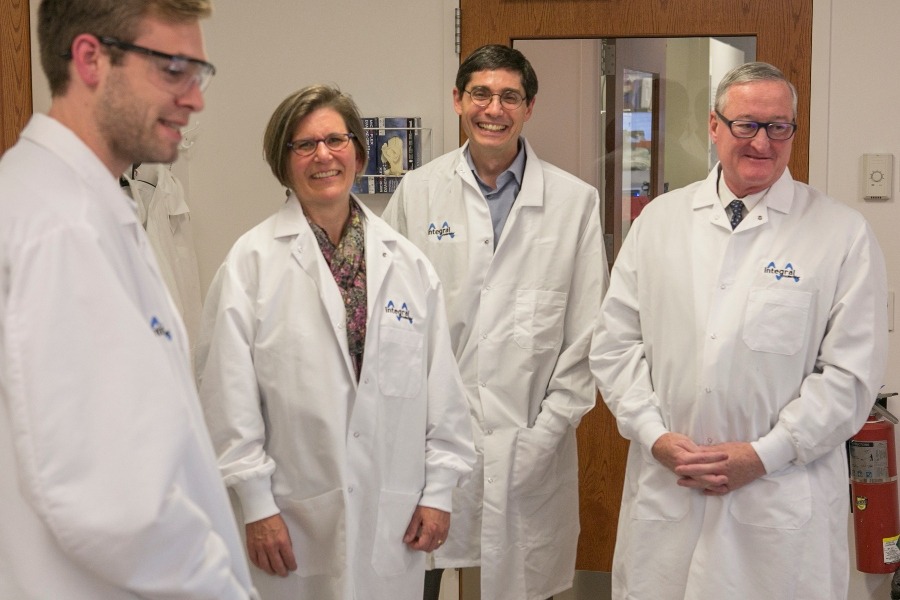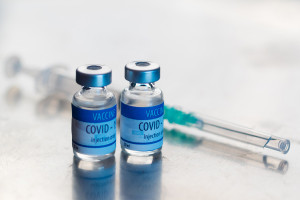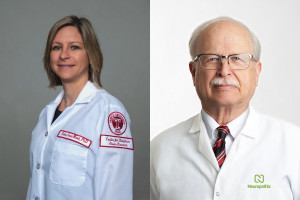Here’s How Long Until a COVID-19 Vaccine Is Ready
We talked to the CEO of Integral Molecular, a Philly biotech company working toward a vaccine, about the challenges and opportunities ahead.

In October, Mayor Jim Kenney delivered remarks and took a tour of Integral Molecular’s new 26,000-square-foot research site. / Courtesy
The COVID-19 outbreak that began nearly three months ago in Wuhan, China has since affected more than 150,000 people across 131 countries, including the United States. As of March 15th, there have been at least 2,815 cases of COVID-19 confirmed by lab tests and 59 deaths in the United States, according to a New York Times database. Pennsylvania has seen 63 positive cases and no deaths, but efforts to contain the virus have led to mass closures and cancellations, panicked shopping, and a call for social distancing. As the virus continues to spread, researchers around the globe are racing against time to discover a therapy to treat those currently infected and a vaccine that could prevent future cases. Integral Molecular, a Philadelphia-based biotechnology company with more than 20 years of experience in developing technologies that help treat viruses and diseases, is part of that effort.
In the past, the company has contributed to the discovery of the receptor for the human immunodeficiency virus (HIV) and lent expertise to national and global efforts to discover cures for other viruses like severe acute respiratory syndrome (SARS) and the Middle East respiratory syndrome (MERS). Now, Integral is one of two local companies leading the charge to discover a vaccine for COVID-19. NextHealth PHL spoke with the president and chief executive officer of Integral Molecular, Ben Doranz, about how his company’s technologies could help researchers better understand how the virus spreads and how close, or far, we might be from discovering a treatment or a vaccine.
NextHealth PHL: Who is involved in the effort to find a vaccine for COVID-19?
Doranz: Integral has a history of working with viruses and pandemics. We helped with the Ebola outbreak and the Zika outbreak, and the Chikungunya virus outbreak over the last several years, but this is something like we’ve never seen before and really requires everyone to work together to find a vaccine and a therapeutic as quickly as possible. We’ve worked with a number of companies and academic laboratories and government agencies on these kinds of projects in the past, and I expect we’ll do this for COVID-19 as well. So far, we’ve worked with the National Institute of Allergy and Infectious Diseases, collaborators at Vanderbilt University, Washington University, Tulane and Berkeley and other groups who are all focused on this effort to create and test vaccines and therapeutics against this virus as quickly as possible. And we’re a part of that effort.
What will Integral Molecular’s key technologies help researchers better understand about how the virus works?
The two key things that everyone is driving forward is the discovery of a vaccine and a therapeutic—you want a drug that can kill the virus or you want a vaccine that can prevent the virus. Everyone is pushing for that, but that takes time. It also takes a lot of technology and resources. Integral Molecular is essentially providing the picks and shovels you need to get there.
Part of those technologies that enable us to discover vaccines and drugs against the virus come from us. So, our shotgun mutagenesis epitope mapping technology tells us how good an immune response is and how effectively someone’s antibodies can kill a virus. Some antibodies are very effective at killing viruses and some antibodies don’t kill viruses at all. Our technology can distinguish between the two. What that helps us do is focus on the types of vaccines that induce the most protection. You want a vaccine that is the most effective, and most preventative; our technology will help us get there.
We’re also asking the question, how does this virus spread so easily and why is it so deadly? The way that viruses infect people and their cells are through receptors. Kind of like a key in a door, the virus has to unlock the doorknob in order to get in. So one of our technologies, called the membrane proteome array, identifies exactly what the doorknobs look like, and helps us identify which doorknob it uses, which receptor it uses, and whether it uses something completely different than previous coronaviruses like SARS and MERS, all things we don’t know yet. It’s possible, and actually very likely, that COVID-19 uses the same receptor that SARS and MERS use, but it may use additional receptors or attachment factors that enhance its infectivity and its pathogenicity. We just don’t know yet. But that’s one of the questions that we’ll be asking.
How long might it take to discover a safe and effective vaccine to prevent COVID-19?
Some vaccines, like the ones that were used against Ebola recently and the Chikungunya virus, have actually been developed quite quickly into the clinic. I expect that the COVID-19 vaccine will be developed very quickly as well. I don’t know if that’s going to be months; I suspect it could be years.
But when you think about fast-tracking, you think about the emergency nature of this kind of pandemic and how to get it to patients as quickly as possible while still being safe. You obviously have to get through the basic tests to make sure that the vaccine is safe and most of the time it takes years. This one is going to be on a very fast track. I don’t know if it’s going to be less than a year. That would be, I think, a record. But certainly, people are going to try to do as much as possible to move this along. Every virus is different, and some are easier to develop vaccines against and some are harder. Where COVID-19 falls on that spectrum is still yet to be determined.
Will we have a therapeutic treatment for COVID-19 sooner than we might have a vaccine?
It usually takes somewhere in the five to 10-year timeframe to develop a therapeutic to market. But in this emergency situation, I expect there are going to be several small-molecule drugs fast-tracked to get to patients in need very quickly. Especially because there are emergency use provisions for when there is no drug, cure or treatment for infected and severely ill patients. So, any treatment, in this case, is better than none.
I am absolutely certain that, within a year, there will be drugs that are being developed against COVID-19 that should prove effective. And if they’re fast-tracked, they could be available to patients very quickly. We work with a lot of collaborators who are part of that mission as well, and we contribute to finding, characterizing and developing therapeutics as quickly as possible, sometimes within a few months.
Has a vaccine ever been fast-tracked for an outbreak of this nature before, and how have previous outbreaks prepared researchers to manage COVID-19 and future viral outbreaks?
One good example is what happened with Zika. For the Zika outbreak, we were part of a project with a group at Vanderbilt who developed a therapeutic drug for Zika within three months, basically from start to finish. At least through animal safety tests, it was ready to go into humans within three months.
They started from essentially samples from infected patients, just like we have now, to isolating antibodies, testing and characterizing those antibodies, and making sure those antibodies are safe and effective. All of that happened within three months, to be ready for human clinical trials.
I think the preparation with previous outbreaks of other viruses has really prepared everyone for this moment when we know what resources we need. It’s just a different virus, but the same process has to take place. We have to understand how it works, how it spreads, and what molecules will be effective in preventing and treating it. All of that’s happening right now.


